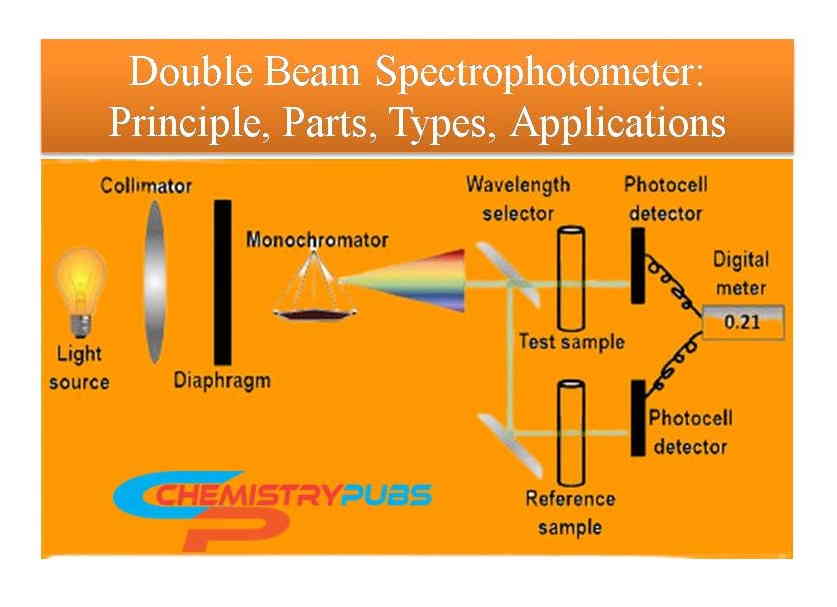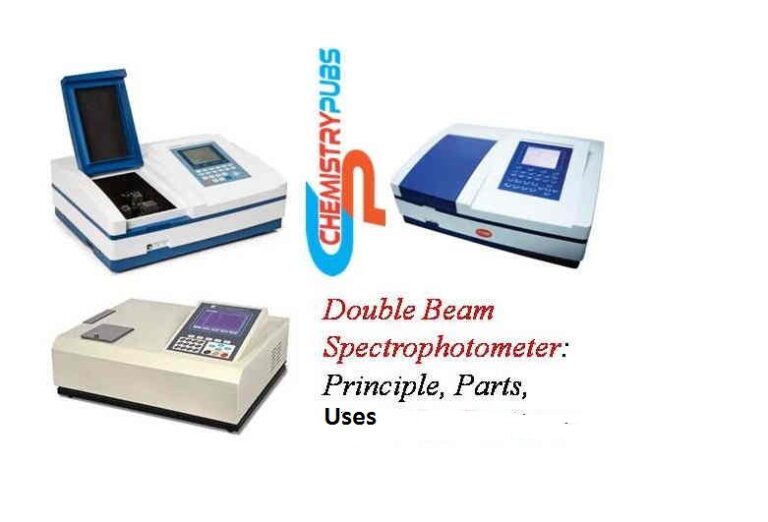A double beam spectrophotometer is crucial lab equipment used for the measurement of light transmittance of analytes in a sample. It measures color in a sample by using double beams. One beam is used to pass through the sample mixture and another beam passes through the reference sample. The light absorbency of these samples can be identified easily without calibration of this instrument. A graduated cylinder is used to contain liquid or gas samples and measure the light absorption property to identify the compound.
At present, the reflection and transmission processes can be obtained by using a broad spectrum of electromagnetic wavelengths in this modern spectrophotometric analytical tool. The electromagnetic wavelengths from this spectrophotometry are visible rays, infrared rays, microwave rays, and ultraviolet rays for the reflection and transmission process.
It consists of photometers that perform radiation of light beams for the measurement process. The intensity of light beams throughout the device can be measured easily by these photometers known as spectrophotometers. The radiated light beams are recorded easily within the single and double-beam spectrophotometer.
This spectrophotometer determines the amount of light for a specific wavelength efficiently. The light beams from the source are absorbed by the analyte within an experimental specimen. The experimental sample of this device can be gases or liquids. The analytes must be dissolved in a solvent to measure the reflection and transmission process. The disks of this device spectrophotometer are made by using a pellet press which has a disk suspended in the experimental specimen while the light beams is passed on.
Definition of double beam UV Vis spectrophotometer?
This device is an advanced technique for the quick measurement of transmittance or reflectance of analytes in a sample mixture. The samples should be used in a solvent which must be transparent or opaque solids, like polished glass, or gases. The light transmission is measured by colorimetric procedures within this instrument. Some biochemical compound produces various colors due to the absorption of visible light or UV (ultraviolet) light. The colorless biochemical compound can be converted to colored compounds for proper identification. This device is very suitable for chromogenic color-forming reactions.
This instrument is designed for measuring the diffusivity of many analytes. The light rays in this device usually cover around the range of 300 nm to 3000 nm by using different controls and calibrations. It needs calibration for this range of wavelengths.
Working principle of double beam spectrophotometer
The working principle of double beam UV-Vis spectrophotometer relates to the reflection and transmittance of the light rays. The strong light beams of double beam UV-Vis spectrophotometer strike the sample. The monochrometer of double beam spectrophotometer selects the specific analytical wavelength light beam from the light source based on the absorbance characteristics of the analyte.
The selected light rays are passed through this double-beam UV-Vis spectrophotometer instrument. The selected light beam consists of a small region of the electromagnetic spectrum. The process of passing the electromagnetic band wavelength depends on the slit methods or monochromatic methods attached to this spectrophotometer. Disperse light rays quality in this monochromator helps in the transmission and reflection process for proper identification.
A rotating disk with three distinct panels in this instrument helps to run this dispersion. A mirror surface is attached to this equipment which shines directly into the specimen cells after passing the light beam through the disk panels.
The cell sample contains a cuvette for a liquid or gaseous specimen that does not absorb light rays in the spectral region of interest of this instrument. A selected solvent is used to dissolve the sample which is kept in the cuvette part of the double-beam UV-Vis spectrophotometer.
The light rays are passed easily through a cuvette part in the reference cell which contains only the solvent instead of striking the specimen after reflecting the light rays at the right angle degrees by the rotating disk and helps to the process of reflection.
There is no arrival of light rays at the photo transducer in this instrument during the third sequence of light rays present after blocking the light rays source beam by the black sector part. No light beam passes through the disk to the sample or specimen at that time. As a result, there is no light rays are present at the photo transducer in the instrument after happening this reason.
The amount of light produced by the photo transducer circuit in this instrument is called the dark current which can be reduced from the overall light measurements made by this double-beam UV-Vis spectrophotometer.
The light rays are passed through the photo transducer or light detector if these rays are not absorbed by this double-beam spectrophotometer. This part converts the arrival light rays into an electrical signal. The signals can be viewed on a computer screen which may be disarrayed instead of straight line. The light beams from this instrument can also be redirected using mirrors and scattered with the help of collimation.
Parts of double beam spectrophotometer
A double beam spectrophotometer has four general parts namely light source, monochromator (an optical system), sample holder, and photometer (detector).
Light source: A Tungsten lamp provides a visible spectrum of light for this instrument. Hydrogen and deuterium lamps provide ultraviolet radiation. Nernst filament or globar provide IR radiation as the light source of this equipment.
Monochromator: This part consists of lenses, an entrance slit, a collimator lens, and an exit slit. Lenses collect the source of radiation and transfer it into the slit. The entrance slit provides a narrow image of the radiation. The collimator lens depicts the light from the entrance slit. It selects the definite spectrum of the light-emitting from the exit slit.
Dispersive device: It consists of a prism and grating which help in dispersing the incident ray of light. The prism activity depends on the refraction of light. The prism must be made from quartz or fused silica for an ultra-violet spectrum below 350 nm.
Sample holder (cuvette): It is a glass tube or quartz material where the sample solution is placed. The sample solution is placed in this holder before the detector and after the dispersive device. It has uniform thickness and optical path length depending on the solution of the sample.
Detector: It is generally known as a photometer which detects the photons after passing the light through the sample solution in the cuvette and gives the signals to the galvanometer for digital display.
Diagram of double beam spectrometer

Advantages of double beam spectrophotometer
The test facility by this tool is quick and consistent acquisition of measurement. It increases the quality of scanning over a wide range of wavelengths. It provides a significant degree of automation and provides comparable detection facilities. It shows the ratio of intensity between the beams of the sample substance and the reference substance.
Limitations of double beam spectrophotometer
The double beam spectrophotometer technique is expensive and shows a considerable challenge.
Applications of Double Beam Spectrophotometer
The double beam UV Spectrophotometer is generally used for DNA analyses, protein analyses, wavelength scanning, and quantitative analyses. This process is essential for measuring visible, near-infrared, and near-ultraviolet light. It is a very effective tool for the analyses of pharmacological substances as well as clinical test specimens.
Frequently Asked Questions (FAQ’s)
What is a double beam spectrophotometer?
It is essential laboratory equipment used to measure the light transmittance of analytes in a sample. It also measures the color in a sample by using double beams. One beam is used to pass through the sample mixture and another beam passes through the reference sample for detecting the photons.
What is the range of wavelength in a double-beam UV-vis spectrophotometer?
The wavelength range of this spectrophotometer is 180 to 1000 nanometers.
What is the function of the sample beam and reference beam in a double beam spectrophotometer?
The sample beam is used to measure the light absorption properties, whereas the reference beam is used to measure the energy of light after passing through the reference standard.
What is the difference between a single-beam and a double beam spectrophotometer?
Two beam of light is used in a double beam spectrophotometer which passes through a reference solution and one passes through the sample. Single beam spectrophotometer uses one beam of light on the sample for analyses.

